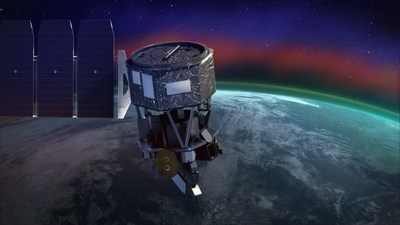NRL launches space weather instrument on NASA satellite
PR Newswire
WASHINGTON, Oct. 11, 2019
WASHINGTON, Oct. 11, 2019 /PRNewswire/ — A U.S. Naval Research Laboratory (NRL) instrument aboard NASA’s Ionospheric Connection Explorer (ICON) satellite will deliver unprecedented information to help scientists investigate how both terrestrial and solar weather impact the ionosphere, the ionized region of Earth’s upper atmosphere. ICON launched from Cape Canaveral, Florida, Oct. 10.

NRL’s MIGHTI (Michelson Interferometer for Global High-Resolution Thermospheric Imaging) will measure wind and temperature profiles and contribute to a critical data set for scientists as they study how energy and dynamics from the lower atmosphere propagate into the space environment.
From its large day-to-day variability to extreme conditions during solar-driven magnetic storms, the ionosphere governs how radio waves propagate and can lead to severe disruptions of radio communications and GPS signals for both the public and the military. Radio signals travel through the ionosphere, or they reflect off the ionosphere to make them reach past Earth’s horizon for the purposes of communication and long-range radar.
“The ionosphere is where Earth ends or where space begins, and we haven’t studied it nearly enough to fully understand how it works and to make reliable predictions,” said Christoph Englert, lead investigator for MIGHTI.
The ionosphere, which overlaps the atmosphere’s mesosphere, thermosphere and exosphere layers, remains somewhat of a mystery to scientists. This border separating Earth from space lies between 30 and 600 miles above the Earth’s surface and is too high for science balloons to reach, and large parts of the region are too low for traditional satellites to fly in.
That’s why NASA wants to explore it from the inside with the ICON satellite, traveling within the ionosphere at an orbit about 350 miles above the Earth’s surface. As one of four scientific instruments aboard the ICON satellite, MIGHTI’s observations will give scientists a better understanding of how weather from the Earth and Sun affect the motion and structure of the neutral and ionized upper atmosphere.
In the years prior to this mission, NRL developed two instruments using similar optical techniques, one for the STS-112 space shuttle mission in 2002 and the other, the SHIMMER instrument, for STPSat-1, launched in 2007. These instruments studied atmospheric chemistry below 60 miles.
MIGHTI is a project developed by NRL in Washington, D.C. and the St. Cloud State University in St. Cloud, Minnesota. The broader collaboration within NRL leveraged the expertise of researchers across multiple Divisions, including Space Science, Spacecraft Engineering, Remote Sensing, Plasma Physics, and Marine Meteorology.
About the U.S. Naval Research Laboratory
The U.S. Naval Research Laboratory is a scientific and engineering command dedicated to research that drives innovative advances for the Navy and Marine Corps from the seafloor to space and in the information domain. NRL is located in Washington, D.C., with major field sites in Stennis Space Center, Mississippi, Key West, Florida, and Monterey, California, and employs approximately 2,500 civilian scientists, engineers and support personnel.
By Mary Estacion, Corporate Communications, U.S. Naval Research Laboratory
Editor Contact: Daniel Parry, U.S. Naval Research Laboratory Public Affairs
[email protected]
202-767-2326
![]() View original content to download multimedia:http://www.prnewswire.com/news-releases/nrl-launches-space-weather-instrument-on-nasa-satellite-300937070.html
View original content to download multimedia:http://www.prnewswire.com/news-releases/nrl-launches-space-weather-instrument-on-nasa-satellite-300937070.html
SOURCE The U.S. Naval Research Laboratory
